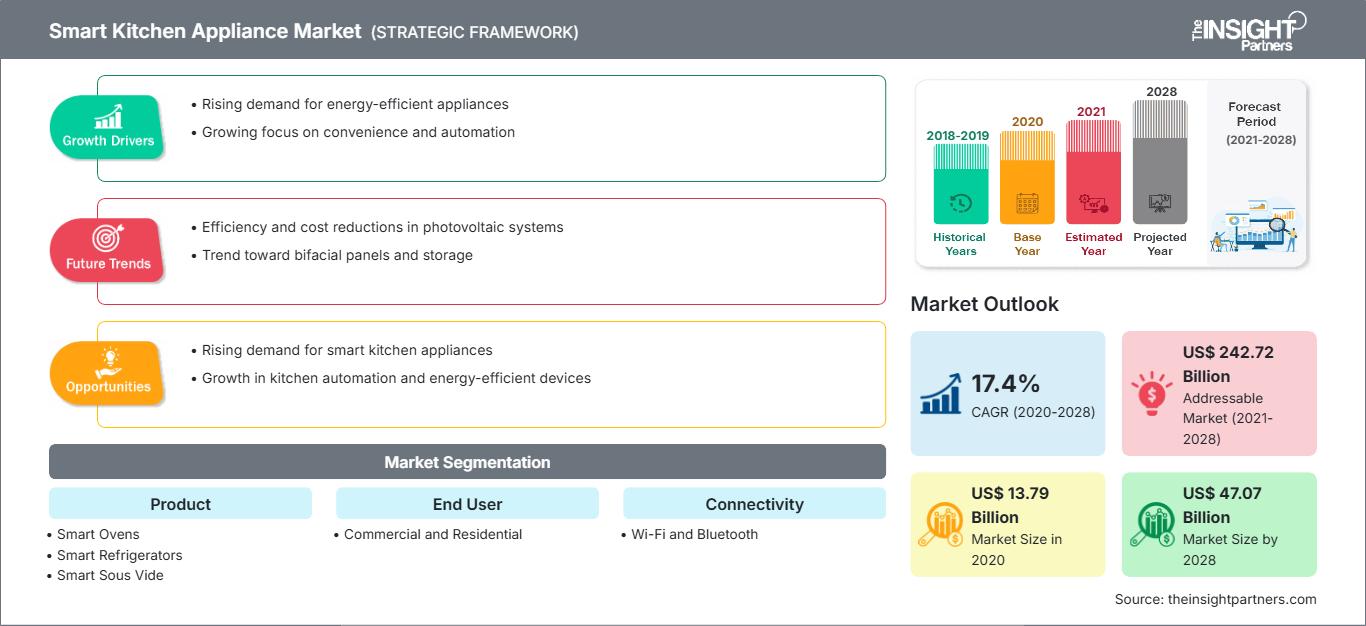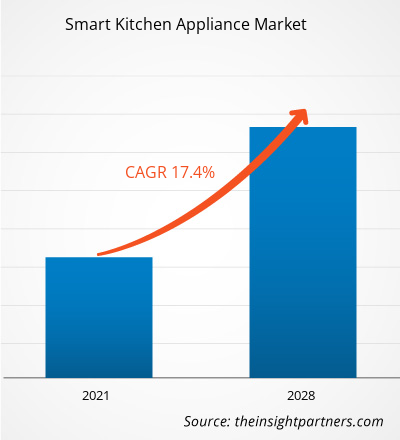全球智能厨房电器市场预计将从 2020 年的 137.86 亿美元增长到 2028 年的 470.712 亿美元;预计 2020 年至 2028 年的复合年增长率为 17.4%。
智能厨房电器的成本效益和通信能力
智能厨房电器是近期创新的技术,在发达国家和发展中国家都越来越受到重视。根据思科互联网报告,联网家庭将占据所有物联网 (IoT) 应用的 48% 份额。智能厨房电器具有成本效益、通信能力、安全性和便利性等诸多优势,从而吸引了最终用户的青睐。
采购智能厨房电器的初始投资较高。然而,从长远来看,这些电器可以帮助客户降低与定期维护和能源消耗相关的经常性成本。传统或现代的电子电器节能效果较差,但需要定期维护,成本高昂。智能厨房电器集成传感器技术,使设备能够感知性能,并在出现任何故障时提醒用户。这降低了重复性成本。例如,LG ThinQ 是 LG 电子为其智能家电提供的一款智能手机应用程序。这些智能家电具有自我诊断功能,最终用户可以使用 LG ThinQ 应用程序访问诊断结果。此外,该应用程序还为用户提供必要的故障排除指导,以便他们诊断问题,无需因小问题联系维修人员。重复性成本的减少促使许多最终用户购买这些智能厨房电器。
同样,智能厨房电器的另一个优势是能够通过无线网络进行通信。这些厨房电器可以通过用户的智能手机相互通信,并与用户通信。智能技术使用户能够远程控制、监控和访问这些电器。智能烤箱等智能厨房电器允许用户通过智能手机打开或关闭炉灶,从而提高了便利性。这一优势正在不断提升终端用户对智能冰箱的需求。此外,智能冰箱集成了各种传感器和内置摄像头,方便用户更新购物清单。
此外,智能冰箱还配备了屏幕,可用作记事本,并可查看温度和能耗模式。智能冰箱用户可以根据冰箱的性能轻松控制和管理冰箱,并通过智能手机在各种模式之间切换。智能冰箱的这些优势使得消费者能够采购用于商业和住宅用途的智能冰箱,从而推动智能厨房电器市场的增长。
自定义此报告以满足您的要求
您将免费获得任何报告的定制,包括本报告的部分内容,或国家级分析、Excel 数据包,以及为初创企业和大学提供超值优惠和折扣
智能厨电市场: 战略洞察

- 获取本报告的主要市场趋势。这个免费样本将包括数据分析,从市场趋势到估计和预测。
您将免费获得任何报告的定制,包括本报告的部分内容,或国家级分析、Excel 数据包,以及为初创企业和大学提供超值优惠和折扣
智能厨电市场: 战略洞察

- 获取本报告的主要市场趋势。这个免费样本将包括数据分析,从市场趋势到估计和预测。
新冠疫情对智能厨电市场的影响
据电子元件行业协会称,新冠疫情导致供应链、产品发布、活动和其他行业相关活动的延迟和中断。由于防控措施以及零部件和原材料供应有限,一些电子产品制造商不得不暂时关闭其生产部门。此外,包括智能厨电在内的各种电子和半导体产品制造商都经历了规定时间表的延误,这对智能厨电市场的供应链产生了负面影响。然而,随着经济复苏和市场自2021年以来获得积极势头,智能厨电市场的供应链在2020年第四季度末开始趋于稳定。
智能厨电市场洞察
智能家居和智能酒店项目大幅增长
全球建筑行业对配备先进技术家电和设备的互联住宅的需求巨大。美国、英国等发达国家以及中国、日本、韩国等发展中国家在智能家居发展方面取得了令人瞩目的进展。美国市场见证了智能家居数量的大幅增长,预计未来几年美国也将经历类似的趋势。美国民众观念的快速转变严重影响了智能音箱、智能恒温器、智能照明和智能安防设备等智能家电的增长。据 Alarm.org 称,57% 的美国人承认,使用智能产品可以节省约 30 分钟的时间。约 47% 的千禧一代正在使用智能家居产品。这些设备在美国乃至全球的普及率都在持续上升。这些智能设备的普及为智能厨房电器开辟了增长途径,因为这些电器是家庭必需品之一。由于全球人口观念的变化,主要是发达国家和一些发展中国家的人们,智能厨房电器的未来预计将会十分光明。
此外,不同地区的酒店业正在采购机器人技术和互联技术,以提高客户满意度。智能电视、语音控制房间、机器人行李寄存和数字礼宾是当前一些突出的智能酒店技术。各酒店管理层都对通过采购智能厨房电器将其厨房改造成智能厨房表现出浓厚的兴趣。基于云的技术与智能手机的集成使酒店和餐馆老板能够远程控制和监控他们的商用厨房电器,从而促进了当前智能厨房电器市场的发展。
基于产品的市场洞察
基于产品,智能厨房电器市场细分为智能烤箱、智能冰箱、智能真空低温烹调器、智能榨汁机和搅拌机、智能炊具和烹饪机器人、智能炉灶、智能和集成烤箱和灶具等。智能冰箱细分市场在 2020 年占据智能厨房电器市场的 33.0% 份额。由于发达国家和发展中国家对智能冰箱和智能烤箱的需求巨大、生活方式的改善、互联网基础设施的增强、物联网 (IoT) 的大幅增长以及住宅和商业厨房对联网设备或电器的需求增加,智能厨房电器市场正在经历激增。
智能冰箱细分市场在 2018 年占据了全球智能厨房电器市场的最大份额,预计在 2021 年至 2028 年期间将占据市场主导地位。另一方面,预计智能烤箱的需求将在未来几年显着增长,从而预示着 2021 年至 2028 年该细分市场前景光明。
基于连接的市场洞察
基于连接性,智能厨房电器市场细分为 Wi-Fi 和蓝牙。 2020 年,Wi-Fi 领域占据智能厨房电器市场的 77.3% 份额,占据主导地位。此外,预计到 2028 年将达到 79.0%。
随着先进传感器、交互式显示面板、摄像头和其他技术的融合,厨房电器正日益智能化。这些技术的整合有助于制造商获得显著的客户吸引力和收入。这使得制造商能够使用 Wi-Fi 连接技术等附加技术升级其产品线。
如今,Wi-Fi 已成为各个地区家庭必不可少的组成部分。智能厨房电器制造商越来越多地将其产品与支持 Wi-Fi 的连接技术解决方案相结合,这使得用户能够从远程位置操作和监控他们的烹饪设备。支持 Wi-Fi 的智能烹饪设备可帮助用户控制和监控两个主要参数——温度和时间。这些优势促使住宅和商业终端用户采购具有 Wi-Fi 连接技术的智能厨房电器。采购量的增加导致了市场的增长。快速发展的互联网基础设施对支持 Wi-Fi 的智能厨房电器的增长至关重要。根据思科年度互联网报告,物联网设备将占所有联网设备的 50%,其中约三分之一将是无线设备。预计这一因素将在未来几年推动采用 Wi-Fi 连接技术的智能厨房电器的增长。
智能烤箱、智能冰箱、智能炉灶、智能咖啡自动售货机以及智能榨汁机和搅拌机都是市场上支持 Wi-Fi 的智能厨房电器。消费者对将厨房电器与 Wi-Fi 连接技术集成的需求日益增长,这推动了 Wi-Fi 连接技术在智能厨房电器中的应用。在当前形势下,这一因素是 Wi-Fi 智能厨房电器市场发展的关键催化剂。
智能厨房电器市场区域洞察
The Insight Partners 的分析师已详尽阐述了预测期内影响智能厨房家电市场的区域趋势和因素。本节还探讨了北美、欧洲、亚太地区、中东和非洲以及南美和中美洲的智能厨房家电市场细分和地域分布。
智能厨房电器市场报告范围
| 报告属性 | 细节 |
|---|---|
| 市场规模 2020 | US$ 13.79 Billion |
| 市场规模 2028 | US$ 47.07 Billion |
| 全球复合年增长率 (2020 - 2028) | 17.4% |
| 历史数据 | 2018-2019 |
| 预测期 | 2021-2028 |
| 涵盖的领域 |
By 产品
|
| 覆盖地区和国家 | 北美
|
| 市场领导者和主要公司简介 |
|
智能厨房电器市场参与者密度:了解其对业务动态的影响
智能厨房电器市场正在快速增长,这得益于终端用户需求的不断增长,而这些需求的驱动因素包括消费者偏好的不断变化、技术进步以及对产品优势的认知度不断提高。随着需求的增长,企业正在扩展产品线,不断创新以满足消费者需求,并抓住新兴趋势,从而进一步推动市场增长。

- 获取 智能厨电市场 主要参与者概述
智能厨房家电市场的参与者采用合并、收购和市场举措等策略来保持其在市场中的地位。以下列出了一些主要参与者的发展:
- 2019 年 11 月,伊莱克斯扩大了与 Google 的合作,将欧洲的联网厨房产品与 Google 助手集成,使消费者能够通过语音命令控制产品。
全球智能厨房家电市场细分为产品、最终用户和连接性。基于产品,智能厨房家电市场细分为智能烤箱、智能冰箱、智能真空低温烹调器、智能榨汁机和搅拌机、智能炊具和烹饪机器人、智能炉灶、智能和集成烤箱和炉灶等。基于最终用户,市场分为商业和住宅。根据连接性,智能厨房家电市场细分为 Wi-Fi 和蓝牙。
Electrolux AB; BSH Hausgeräte GmbH; GE Appliances; LG电子、荷兰皇家飞利浦公司、松下公司、三星电子有限公司、Breville集团有限公司、惠而浦公司和Vita-Mix公司是本次研究的主要智能厨房家电市场参与者。此外,本研究报告还研究和分析了其他几家重要的智能厨房家电市场参与者,以全面了解全球智能厨房家电市场及其生态系统。
- 历史分析(2 年)、基准年、预测(7 年)及复合年增长率
- PEST和SWOT分析
- 市场规模、价值/数量 - 全球、区域、国家
- 行业和竞争格局
- Excel 数据集
近期报告
客户评价
购买理由
- 明智的决策
- 了解市场动态
- 竞争分析
- 客户洞察
- 市场预测
- 风险规避
- 战略规划
- 投资论证
- 识别新兴市场
- 优化营销策略
- 提升运营效率
- 顺应监管趋势






















 获取免费样品 - 智能厨电市场
获取免费样品 - 智能厨电市场